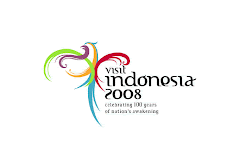
Indonesian culinary foods are various, and of course, mostly are very delicious. Since Indonesia have lots of island, spread over from West (Sumatra, Java, Bali, Madura, Borneo) to East (Maluku and Papua) so that the culinary are differ among the islands and each of them very rich in local traditions. People usually made the food with ingredients from natural spice, brings the food for traditional ceremony and share with others to eat together.
When you come to Surakarta (or usually called Solo) and Jogjakarta, Central Java, every 12th days of Javanese month (Mulud), you can enjoy Gerebeg Mulud, the culmination of Sekaten Ceremony. This festival start at early morning preceded by parade of the palace guard with their magnificent uniform.
In this ceremony, the local people will take a little bit of Gunungan. The Gunungan is made of food such as vegetables, peanuts, red pepper, egg and several delicacies made of sticky rice. Its mountain shaped symbolizes the prosperity and wealth of Mataram's land (in the present-day province of Jogjakarta).
Besides for ceremony, cuisine is also take part as important things in social culture. That makes every regions in Indonesia have their own food and cuisine specialty. Jogjakarta, for instance, has Gudeg (a traditional food young nangka (jack fruit) among other things, boiled for several hours with palm sugar and some spices, thus it tastes sweet) as its food specialty, while Surakarta has Nasi Liwet (rice cooked with coconut oil, served with boiled egg, chicken curry called Opor and hot spicy squash curry called Sambal Goreng Labu Siam). And Magelang has specialty in Kupat Tahu (tofu served with Ketupat - a type of dumpling made from rice that has been wrapped in a woven palm leaf pouch which is then boiled - and sweet Petis, a sauce made from sweet soya sauce and fermented prawn paste).
Jogjakarta, Surakarta and Magelang's cuisines are included in Javanese Cuisine, which is largely divided into three major groups:
1. Central Javanese cuisine (masakan Jawa Tengah)
2. East Javanese cuisine (masakan Jawa Timur)
3. Common Javanese dishes
There are similarities in the two cuisines, but the main differences lie in the flavors. Central Javanese cuisine is sweeter and less spicy, while East Javanese cuisine uses less sugar and more chili, possibly influenced by Madurese cuisine.
Rice is the common staple food (commonly called nasi in bahasa Indonesia or sego in Javanese), and served with every meal. Gaplèk, or dried cassava, is sometimes mixed into rice or replaces rice. Bread and grains other than rice are uncommon, although noodles are often served as accompaniment to rice. Potatoes usually accompany rice too.
Almost 90% of Javanese are Muslim, and consequently, Javanese cuisine never contains pork. Only a few ethnic groups in Indonesia use pork in their cuisine, most prominently in Indonesian Chinese cuisine, Manado cuisine and Balinese cuisine.
(Some parts of this article are taken from Wikipedia. Insert Photo: Kupat Tahu Stall in Magelang, Central Java, by moderator.)



No comments:
Post a Comment